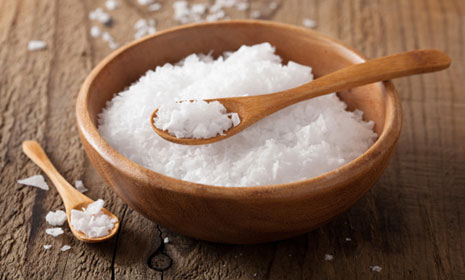
Over the past few years, our daily consumption of salt has dropped but we’re still consuming more than the 6g (approximately 1 tsp) recommended for adults – and that figure’s even less for children.
Campaign groups, such as CASH (Consensus Action on Salt and Health), have successfully worked with Government and food manufacturers to bring down the amount of salt in processed foods, which has resulted in falls in blood pressure figures – a key indicator that reducing your salt intake reaps results.
Here we'll be looking at how to reduce the salt in your diet, with practical tips and advice.
Reduce your risk
Although salt does not affect blood glucose levels, it’s important to limit the amount you eat as part of your diabetes management because too much salt can raise your blood pressure. People with diabetes are more likely to be affected by high blood pressure, which increases the risk of heart disease, stroke and kidney disease.
And if that isn’t enough incentive to cut down, worryingly, we also know that too much salt increases our risk of stomach cancer.
Being aware of the sources of added salt and following a few simple steps you can easily reduce the amount of salt you eat.
The main sources of salt...
- processed food, such as ready meals and takeaways
- salty meats, such as ham, bacon and sausages
- salted snacks, such as crisps, popcorn, salted nuts and biscuits
- stock cubes, gravy powder and soy sauce
- cheese
- prawns, smoked fish and anchovies
- ketchup, mayonnaise, pickles, ketchup
- bread and breakfast cereals
- canned food containing salt
- canned, packed and instant soups
- sandwiches.
Four top tips to reduce your salt intake
- Reduce the amount you use in cooking and measure what you add instead of just shaking the salt cellar over the pan! As your taste buds adapt to less salt, aim to cut it out completely.
- Instead of buying processed food cook from scratch. Using fruit, vegetables, milk, potatoes, rice and pulses, which are generally low in salt.
- We lead busy lives, so there will be occasions when we turn to ready meals, but try not to buy them too often and look at the ‘front of pack’ label. Choose foods where labelling is green or amber for salt, rather than red.
- Don’t add salt to food you’ve cooked or are served in a restaurant until you’ve tasted it – probably something we are all guilty of – and even better, flavour your food with herbs and spices instead of using the salt shaker. Often we sprinkle salt on food out of habit more than need.
7 ways to pass the salt
- Try paprika, ground white or black pepper, chives and mild chili powder on potatoes.
- Flavour white fish with lemon or mixed herbs.
- Ginger, dill and spring onion is delicious on oily fish, such as salmon.
- Chop coriander on your curries.
- Add flavour to pasta, using garlic or basil.
- Marjoram and rosemary works well on pork.
- Thyme and sage works well on chicken and turkey.
Shopping
When shopping, look out for reduced-salt options of your favourite foods. You can now buy reduced-salt ketchup, baked beans and even soy sauce.
Ketchup
Standard ketchup has nearly double the amount of salt compared to the reduced sugar and salt version.
- 100g standard ketchup has 2.2g salt compared with 1.3g for reduced sugar and salt ketchup.
To cut down the salt further, why not make your own tomato salsa to flavour food instead of using ketchup? Try this salsa recipe from our recipe finder.
Baked beans
Buying reduced-salt and sugar baked beans instead of the standard version can make a salt saving, too.
- 100g of standard beans has 0.6g salt and 21.3g sugar compared with 0.4g salt and 5g sugar for reduced salt and sugar beans.
Stock cubes and gravy granules
Shop-bought stock is high in salt.
- 70ml gravy granules serving has 0.8g salt compared with 0.5g for the reduced salt version.
- One brand of standard beef stock cubes has 0.97g salt per 100ml and 0.7g for a reduced salt version.
Check out the tins
Go for tinned fish, beans and vegetables canned in spring water instead of brine and check out different brands of your favourite foods, too.
Shop around
Spending a bit of extra time in supermarkets or going online comparing brands can really pay off. You’ll be surprised to see how the salt content of foods such as breakfast cereals, sandwiches, pizzas and sausages can vary.
Salt Q&A
Is rock or sea salt healthier than table salt?
Though it’s often promoted as being natural and healthy, the more expensive salts you can find on supermarket shelves are no different to standard salt – they still add unnecessary sodium chloride to your diet.
What about reduced-sodium salt?
Some people use reduced-sodium replacement salt. These have had the sodium replaced by potassium, which reduces the salt content but if you have kidney disease too much potassium can be unsafe, so speak to your healthcare team first before you use it.
Is there salt in soluble vitamin supplements or painkillers?
If you regularly take an effervescent (dissolvable) vitamin supplement, or take effervescent painkillers when necessary, it’s worth remembering that these can contain up to 1g salt per tablet. You may therefore wish to consider changing to a non-effervescent tablet, particularly if you have been advised to watch or reduce your salt intake. Speak to your healthcare team for individual advice.
